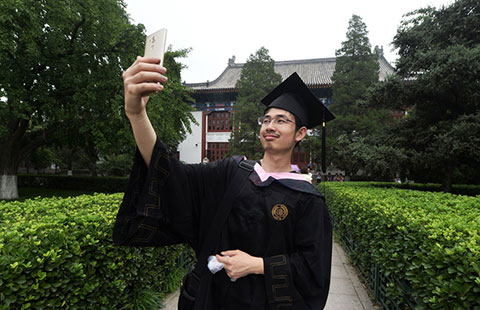Tang Dynasty and silk roads
(chinadaily.com.cn) Updated: 2016-06-27 11:44

The Routes Network of the Chang’an-Tianshan Corridor, jointly submitted by China, Kazakhstan and Kyrgyzstan, was inscribed in the list of World Cultural Heritage Sites on June 22, 2015. The site of Weiyang Palace, the site of Daming Palace, the Giant Wild Goose Pagoda, the Small Wild Goose Pagoda, the Xingjiao Temple, The Tomb of Zhang Qian and the Bin County Cave Temple in Shaanxi are all included. The seven sites are typical representatives of the Silk Road’s operation, development, and prosperous culmination, and are of significant value in the history of civilization.
On August 31, 2015, UNESCO Director-General Irina Georgieva Bokova gave the world cultural heritage certificate for Silk Roads: the Routes Network of the Chang’an-Tianshan Corridor to Lou Qinjian, governor of Shaanxi province.
The Tang Dynasty (AD 618-907) was founded at the beginning of the seventh century, and became one of the greatest centers of power in the world.
Agriculture, the handicraft industry and commercial trade were well-developed in the Tang Dynasty. In particular, the silk textile and ceramic industries, which came under the aegis of the handicraft industry, were world-famous. Tri-colored glazed pottery, or Tang San Cai, comes from this era. As the economy prospered, the Tang Dynasty saw unprecedented development in science, culture and the arts. Its masterpieces of calligraphy and painting are examples for others to follow through the ages, and its poetry is incandescent to this day. As a whole, society at that time was open and receptive towards foreign cultures. Outstanding cultural achievements were constantly emerging, making the Tang Dynasty the Golden Era for the development of Chinese civilization.
 |
| Modern Xi'an at night. [Photo provided to chinadaily.com.cn] |
- Xi orders more troops to join flood control
- Naval drill is fully within country's 'sovereign rights'
- Drug price reform will 'improve services'
- Xi orders more troops to join flood control
- Ex-diplomat: Philippines must forgo provocations
- 2017 pollution targets 'in reach'
- Li: Ensure safety in flood areas
- China's defense ministry confirms drill in South China Sea
- Li: Piraeus to become 'top-level' gateway
- Response to 'fully depend' on Manila







